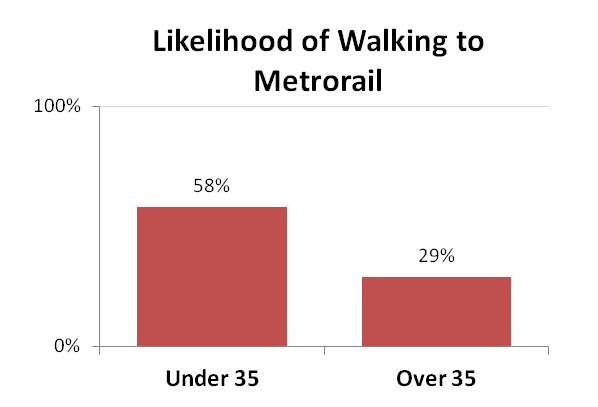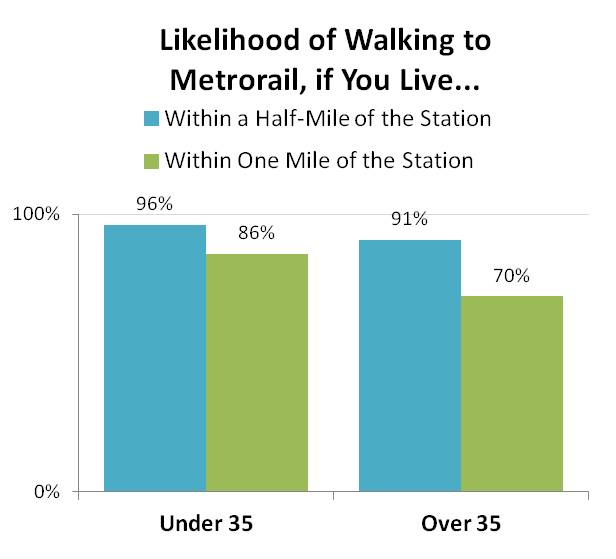Time for Those Walking Shoes, Part 2
Walk access to Metrorail has increased 15% over the last 5 years, especially from those living within a half-mile of the station.
So more rail riders are choosing to walk to their Metrorail station, according to the 2012 Metrorail Passenger Survey. But who are these pedestrians?
Around 40% of Metrorail customers in the AM peak walk to the station. The survey found that younger people are much more likely to walk, with those under 35 were nearly twice as likely to walk to the train as those over 35:
 However, younger Metrorail riders are also more likely to live within walking distance of their Metrorail station. Half of all riders under 35 live within a half-mile Metrorail, while 22% of those over 35 do. Younger people in our region generally are slightly more likely to live near Metrorail – 15% of everyone under 35 in the region lives within a half-mile of Metrorail, 12% for those over 35. The chart below shows how younger riders tend to live closer to Metrorail:
However, younger Metrorail riders are also more likely to live within walking distance of their Metrorail station. Half of all riders under 35 live within a half-mile Metrorail, while 22% of those over 35 do. Younger people in our region generally are slightly more likely to live near Metrorail – 15% of everyone under 35 in the region lives within a half-mile of Metrorail, 12% for those over 35. The chart below shows how younger riders tend to live closer to Metrorail:
If we look at riders while holding walk distance constant, age becomes less of an explanation of riders’ willingness to walk. The chart below shows only riders who live a half-mile or one mile away from their station.
 The vast majority of riders who live within a half-mile of the station walk, regardless of age. Younger people are slightly more willing to walk, all else equal. Younger people are more willing to take longer walks, as well.
The vast majority of riders who live within a half-mile of the station walk, regardless of age. Younger people are slightly more willing to walk, all else equal. Younger people are more willing to take longer walks, as well.
What does this mean for Metro? Increased walking has implications for the future of Metro’s feeder bus, parking, and pedestrian and bicycle infrastructure to rail stations. One main question for Metro and the region is, Will the riders who are under 35 today will continue to walk to (and demand housing near) Metro, even as they age past 35? If this preference for walkability to transit continues to follow this cohort, we should expect to see continuing growth in walk access and demand for pedestrian connections.
What do you see in these numbers? What does this imply for our future?



Interesting. Will you be releasing the raw data from the survey?
And have you asked the same questions previously? If so, how do the numbers compare?
Did the survey instrument ask about whether or not the surveytakers have children? I’m curious to know if that is the real explanatory variable rather than age in determining willingness to walk to stations, after controlling for walk distance. If the housing stock patterns generally follow that more small units are near stations and a larger percentage of say, 1400-1800+ sq ft units are located away from stations, then you might get more families moving further away from stations because they cannot find/afford housing stock that meets their increasing sq ft desires within 1/2-mile. Of course, having to get a child to daycare in a two-worker household also instantly transforms the one dropping the kid at daycare into a park/ride commuter to Metro unless they live within walking distance of the Metro and daycare.
@Sue Thanks! The 2012 rail survey was the first (to my knowledge) that asked riders their age, so I don’t believe we can compare to previous years. I don’t think we plan to release the raw data of the survey, but we will keep you posted here. Any specific crosstab etc. you had in mind?
@CityBeautiful21 Good questions, and a good hypothesis to investigate. Unfortunately the survey may not be the best data source for it, since it didn’t ask much about riders’ household status. The American Community Survey may be a good place to research this question – assume that people whose primary means of transportation to work was “railroad” or “subway” as a loose proxy for Metrorail, and cross-tab with other characteristics?
Pretty interesting to see that age is not a direct correlation to whether people will walk or not. Obviously distance plays a huge part, but it’s a good sign to see more people willing to walk than to drive and it’s better for the environment as well. Did the survey take into account bicyclists though? I’d imagine a lot of people ride bikes and the stations have places to lock bikes as well.